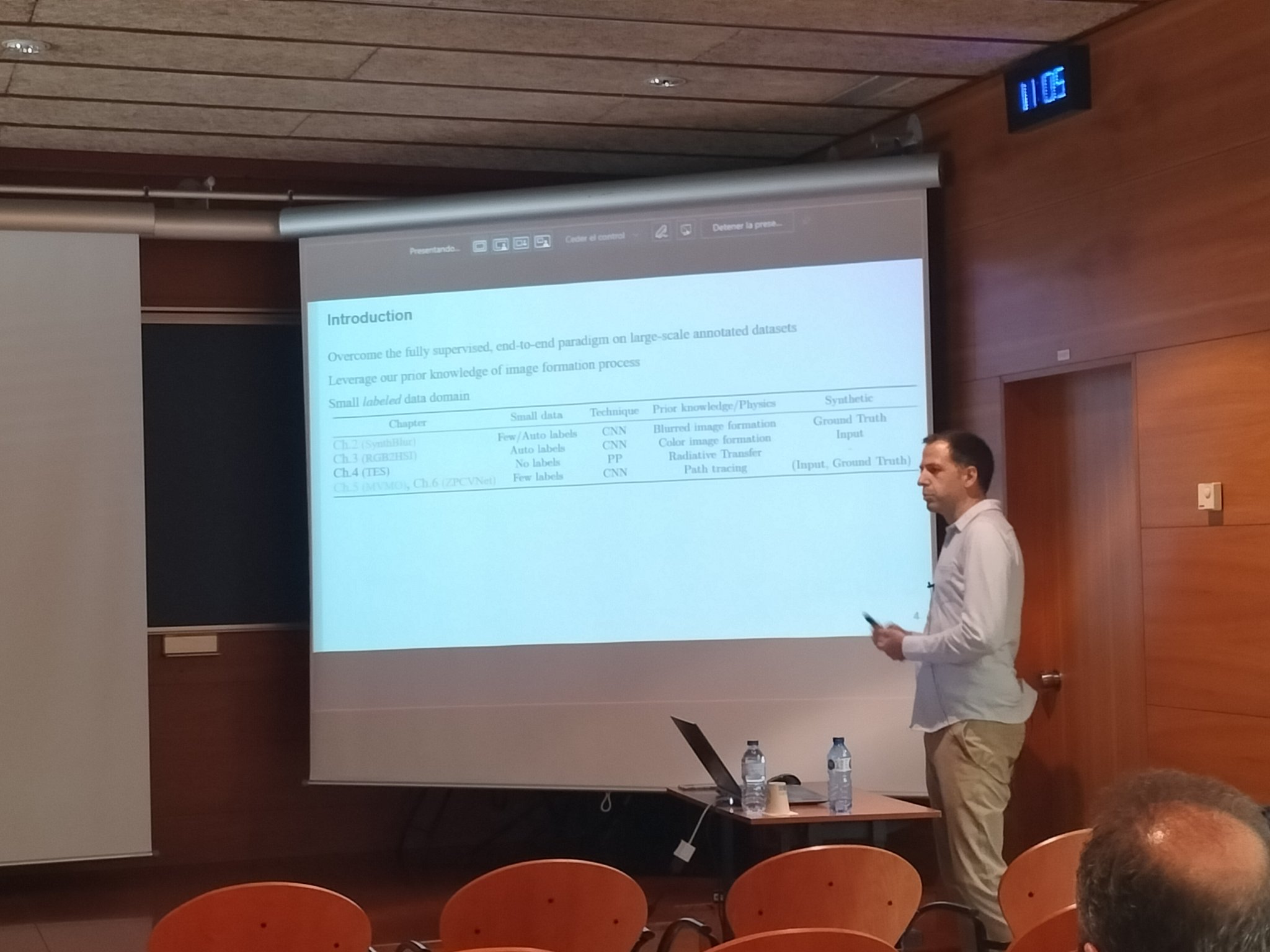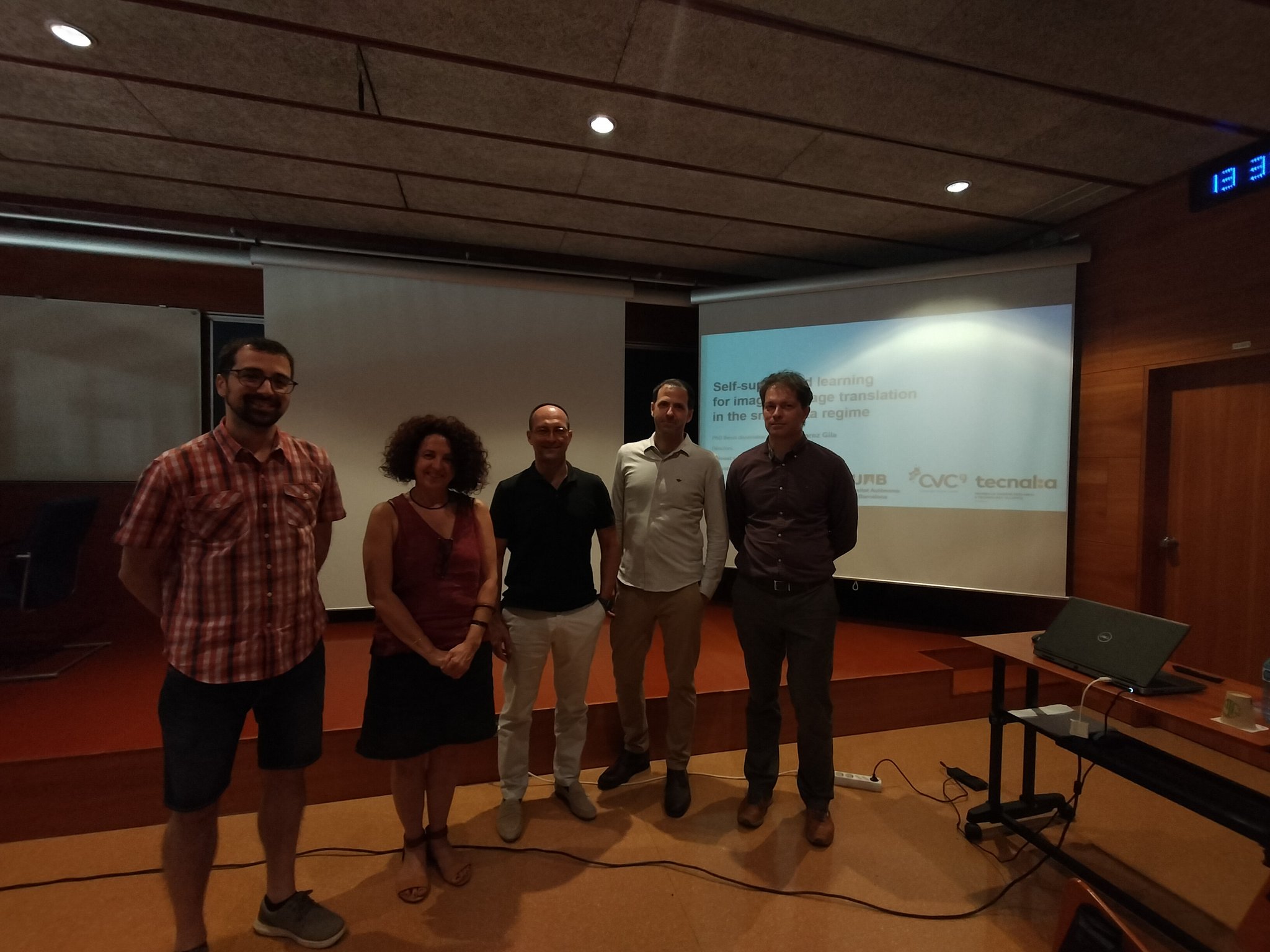
CVC has a new PhD on its record!
Aitor Álvarez successfully defended his dissertation on Computer Science on July 19, 2022, and he is now Doctor of Philosophy by the Universitat Autònoma de Barcelona.
What is the thesis about?
The mass irruption of Deep Convolutional Neural Networks (CNNs) in computer vision since 2012 led to a dominance of the image understanding paradigm consisting in an end-to-end fully supervised learning workflow over large-scale annotated datasets. This approach proved to be extremely useful at solving a myriad of classic and new computer vision tasks with unprecedented performance —often, surpassing that of humans—, at the expense of vast amounts of human-labeled data, extensive computational resources and the disposal of all of our prior knowledge on the task at hand. Even though simple transfer learning methods, such as fine-tuning, have achieved remarkable impact, their success when the amount of labeled data in the target domain is small is limited. Furthermore, the non-static nature of data generation sources will often derive in data distribution shifts that degrade the performance of deployed models. As a consequence, there is a growing demand for methods that can exploit elements of prior knowledge and sources of information other than the manually generated ground truth annotations of the images during the network training process, so that they can adapt to new domains that constitute, if not a small data regime, at least a small labeled data regime.
This thesis targets such few or no labeled data scenario in three distinct image-to-image mapping learning problems. It contributes with various approaches that leverage our previous knowledge of different elements of the image formation process: We first present a data-efficient framework for both defocus and motion blur detection, based on a model able to produce realistic synthetic local degradations. The framework comprises a self-supervised, a weakly-supervised and a semi-supervised instantiation, depending on the absence or availability and the nature of human annotations, and outperforms fully-supervised counterparts in a variety of settings.
Our knowledge on color image formation is then used to gather input and target ground truth image pairs for the RGB to hyperspectral image reconstruction task. We make use of a CNN to tackle this problem, which, for the first time, allows us to exploit spatial context and achieve state-of-the-art results given a limited hyperspectral image set.
In our last contribution to the subfield of data-efficient image-to-image transformation problems, we present the novel semi-supervised task of zero-pair cross-view semantic segmentation: we consider the case of relocation of the camera in an end-to-end trained and deployed monocular, fixed-view semantic segmentation system often found in industry. Under the assumption that we are allowed to obtain an additional set of synchronized but unlabeled image pairs of new scenes from both original and new camera poses, we present ZPCVNet, a model and training procedure that enables the production of dense semantic predictions in either source or target views at inference time. The lack of existing suitable public datasets to develop this approach led us to the creation of MVMO, a large-scale Multi-View, Multi-Object path-traced dataset with per-view semantic segmentation annotations. We expect MVMO to propel future research in the exciting under-developed fields of cross-view and multi-view semantic segmentation.
Last, in a piece of applied research of direct application in the context of process monitoring of an Electric Arc Furnace (EAF) in a steelmaking plant, we also consider the problem of simultaneously estimating the temperature and spectral emissivity of distant hot emissive samples. To that end, we design our own capturing device, which integrates three point spectrometers covering a wide range of the Ultra-Violet, visible, and Infra-Red spectra and is capable of registering the radiance signal incoming from an 8cm diameter spot located up to 20m away. We then define a physically accurate radiative transfer model that comprises the effects of atmospheric absorbance, of the optical system transfer function, and of the sample temperature and spectral emissivity themselves. We solve this inverse problem without the need for annotated data using a probabilistic programming-based Bayesian approach, which yields full posterior distribution estimates of the involved variables that are consistent with laboratory-grade measurements.
Keywords: computer vision, neural networks, self-supervised learning, image-to-image mapping, probabilistic programming.















